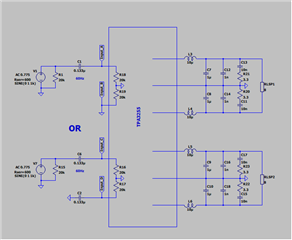Tool/software:
Interested in making the simplest possible SE input circuit for a BTL configurated TPA3255, to be used from 60Hz up, with an 6dB input filter.
1: Can input_B be connected directly to ground instead of a capacitor of the same value as input_D as normally used?
2: Except for half gain, will there be any performance or sound degradation when going SE like in the sketch below? Input_C and input_D via cap if necessary?
3: If BTL is not possible, we could use the chip SE connected.
Looking forward to your reply.
Lars Soderquist
Racer Direkt AB
Sweden



